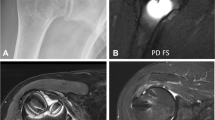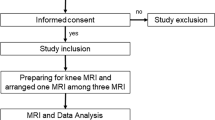Abstract
The purpose of this study was to assess the optimal reconstruction parameters and the influence of tube current in extensor tendons three-dimensional computed tomography (3D CT) using deep learning reconstruction, using iterative reconstruction as a reference. In the phantom study, a cylindrical phantom with a 3 mm rod simulated an extensor tendon was used. The phantom images were acquired at tube current of 50, 100, 150, 200, and 250 mA. In the clinical study, CT scans of hand tendons were performed on nine hands from eight patients. All images were reconstructed using advanced intelligent clear-IQ engine (AiCE) parameters (body, body sharp, brain CTA, and brain LCD) and adaptive iterative dose reduction three dimensional (AIDR 3D). The objective image quality for tendon detectability was evaluated by calculating the low-contrast object specific contrast-to-noise ratio (CNRLO) in the phantom study and CNR and coefficient of variation (CV) in the clinical study. In the phantom study, CNRLO (at 200 mA) of AiCE parameters (body, body sharp, brain CTA, and brain LCD) and AIDR 3D were 5.2, 5.3, 5.3, 5.8, and 5.0, respectively. In the clinical study, AiCE brain CTA was higher CNR and lower CV values compared to other reconstruction parameters. AiCE without dose reduction may be an effective strategy for further improving the image quality of extensor tendons 3D CT. Our study suggests that the AiCE brain CTA is more suitable for extensor tendons 3D CT compared to other AiCE parameters.







Similar content being viewed by others
References
Middleton WD, Teefey SA, Boyer MI (2001) Hand and wrist sonography. Ultrasound Q 17(1):21–36. https://doi.org/10.1097/00013644-200103000-00004
Meraj S, Gyftopoulos S, Nellans K, Walz D, Brown MS (2017) MRI of the extensor tendons of the wrist. Am J Roentgenol 209(5):1093–1102. https://doi.org/10.2214/AJR.17.17791
Abrar DB, Schleich C, Nebelung S, Frenken M, Radke KL, Vordenbäumen S et al (2020) High-resolution MRI of flexor tendon pulleys using a 16-channel hand coil: disease detection and differentiation of psoriatic and rheumatoid arthritis. Arthritis Res Ther 22(1):1–10. https://doi.org/10.1186/s13075-020-2135-0
Pelc JS, Beaulieu CF (2001) Volume rendering of Tendon-Bone Relationships using unenhanced CT. Am J Roentgenol 176(4):973–977. https://doi.org/10.2214/ajr.176.4.1760973
Sunagawa T, Ochi M, Ishida O, Ono C, Ikuta Y (2003) Three-dimensional CT imaging of flexor tendon ruptures in the hand and wrist. J Comput Assist Tomogr 27(2):169–174. https://doi.org/10.1097/00004728-200303000-00012
Sunagawa T, Ishida O, Ishiburo M, Suzuki O, Yasunaga Y, Ochi M (2005) Three-dimensional computed tomography imaging: its applicability in the evaluation of extensor tendons in the hand and wrist. J Comput Assist Tomogr 29(1):94–98. https://doi.org/10.1097/01.rct.0000148275.22548.44
Takagi T (2019) Standardization in X-ray CT Imaging -GALACTIC-, 2nd edn. Japanese Society of Radiological Technology, Japan, pp 156–157
Arndt C, Güttler F, Heinrich A, Bürckenmeyer F, Diamantis I, Teichgräber U (2021) Deep learning CT image reconstruction in clinical practice. Rofo 193(3):252–261. https://doi.org/10.1055/a-1248-2556
Singh R, Digumarthy SR, Muse VV, Kambadakone AR, Blake MA, Tabari A et al (2020) Image quality and lesion detection on deep learning reconstruction and iterative reconstruction of submillisievert chest and abdominal CT. Am J Roentgenol 214(3):566–573. https://doi.org/10.2214/AJR.19.21809
Lenfant M, Chevallier O, Comby PO, Secco G, Haioun K, Ricolfi F et al (2020) Deep learning versus iterative reconstruction for CT pulmonary angiography in the emergency setting: improved image quality and reduced radiation dose. Diagnostics 10(8):558. https://doi.org/10.3390/diagnostics10080558
Bernard A, Comby PO, Lemogne B, Haioun K, Ricolfi F, Chevallier O, Loffroy R (2021) Deep learning reconstruction versus iterative reconstruction for cardiac CT angiography in a stroke imaging protocol: reduced radiation dose and improved image quality. Quant Imaging Med Surg 11(1):392–401. https://doi.org/10.21037/qims-20-626
Tamura A, Mukaida E, Ota Y, Nakamura I, Arakita K, Yoshioka K (2022) Deep learning reconstruction allows low-dose imaging while maintaining image quality: comparison of deep learning reconstruction and hybrid iterative reconstruction in contrast-enhanced abdominal CT. Quant Imaging Med Surg 12(5):2977–2984. https://doi.org/10.21037/qims-21-1216
Zhang D, Mu C, Zhang X, Yan J, Xu M, Wang Y, Jin Z (2023) Image quality comparison of lower extremity CTA between CT routine reconstruction algorithms and deep learning reconstruction. BMC Med Imaging 23(1):33. https://doi.org/10.1186/s12880-023-00988-6
Tsuboi K, Osaki N, Ohtani Y, Tanikawa K, Kaneko M (2022) Influence of field of view size and reconstruction methods on single-energy metal artifact reduction: a phantom study. Phys Eng Sci Med 45(2):637–642. https://doi.org/10.1007/s13246-022-01130-6
Urikura A, Hara T, Ichikawa K, Nishimaru E, Hoshino T, Yoshida T, Nakaya Y (2016) Objective assessment of low-contrast computed tomography images with iterative reconstruction. Phys Med 32(8):992–998. https://doi.org/10.1016/j.ejmp.2016.07.003
Abramoff MD, Magalhaes PJ, Ram SJ (2004) Image processing with ImageJ. Biophotonics Int 11(7):36–42
Ichikawa K, (2012–2014) CTmeasure http://www.jsct-tech.org/, Accessed 2012–2014
Kanda Y (2013) Investigation of the freely available easy-to-use software ‘EZR’ for medical statistics. Bone Marrow Transplant 48(3):452–458. https://doi.org/10.1038/bmt.2012.244
Acknowledgements
The authors thank Ms. Kyoko Ito (Canon Medical Systems) and all the radiological technologist at Gero Hospital for their advice and assistance throughout this study.
Funding
The authors declare that no funds, grants, or other support were received during the preparation of this manuscript.
Author information
Authors and Affiliations
Contributions
KT contributed to the study design, data collection, and writing and editing of this article; TK and HM contributed to the study design, data collection, and reviewing of this article; YO, KT, and MK contributed to the project administration and reviewing of this article. All authors read and approved the final manuscript.
Corresponding author
Ethics declarations
Competing interests
The authors have no relevant financial or non-financial interests to disclose.
Ethics approval
This study was performed in line with the principles of the Declaration of Helsinki. Approval was granted by the Hospital Ethics Committee (June 3, 2022; No.48 and March 29, 2023; No.283).
Informed consent
Our Hospital Ethics Committee waived the requirement for individual informed consent due to the retrospective nature of the study.
Additional information
Publisher’s Note
Springer Nature remains neutral with regard to jurisdictional claims in published maps and institutional affiliations.
Rights and permissions
Springer Nature or its licensor (e.g. a society or other partner) holds exclusive rights to this article under a publishing agreement with the author(s) or other rightsholder(s); author self-archiving of the accepted manuscript version of this article is solely governed by the terms of such publishing agreement and applicable law.
About this article
Cite this article
Tsuboi, K., Kanbe, T., Matsushima, H. et al. Three-dimensional CT imaging in extensor tendons using deep learning reconstruction: optimal reconstruction parameters and the influence of dose. Phys Eng Sci Med 46, 1659–1666 (2023). https://doi.org/10.1007/s13246-023-01326-4
Received:
Accepted:
Published:
Issue Date:
DOI: https://doi.org/10.1007/s13246-023-01326-4




